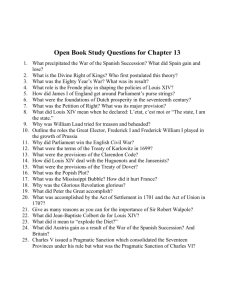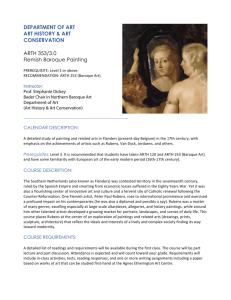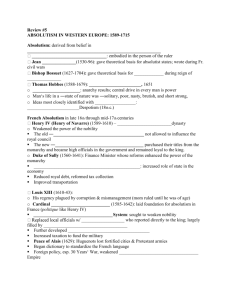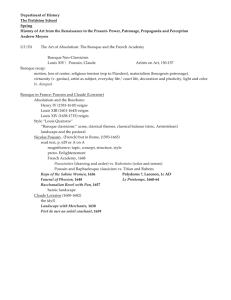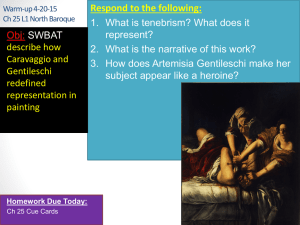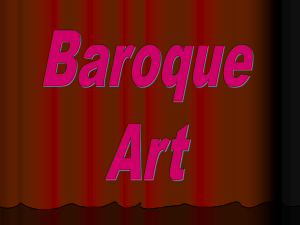AP Chapter 25--- Northern Baroque, 1600s---Flemish
advertisement
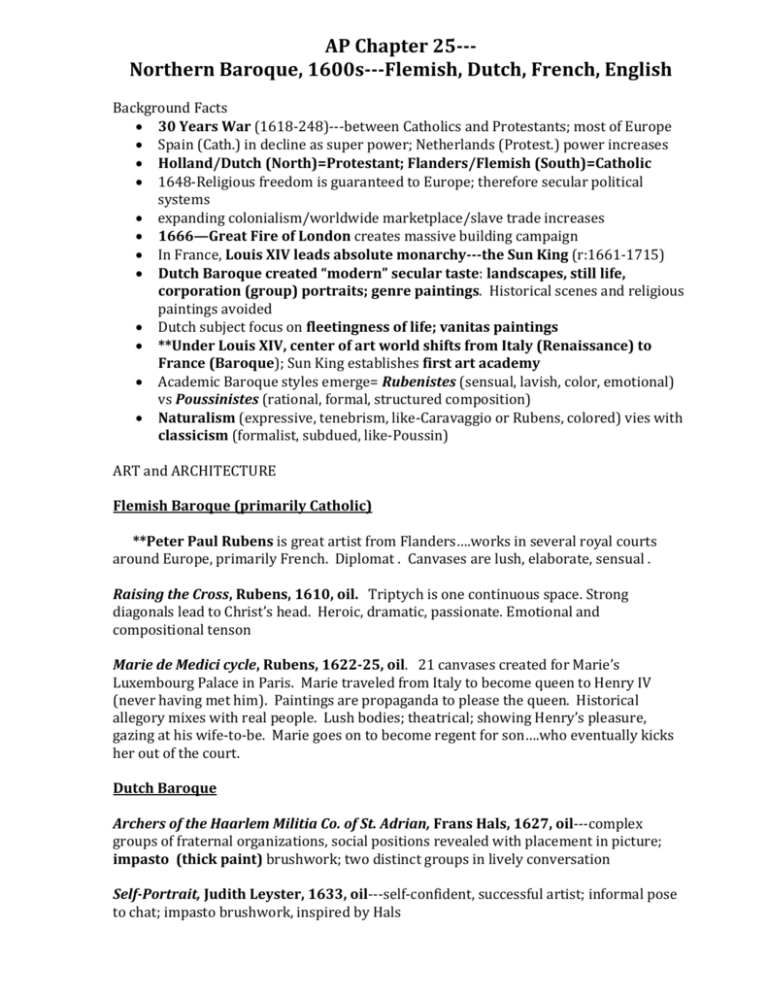
AP Chapter 25--Northern Baroque, 1600s---Flemish, Dutch, French, English Background Facts 30 Years War (1618-248)---between Catholics and Protestants; most of Europe Spain (Cath.) in decline as super power; Netherlands (Protest.) power increases Holland/Dutch (North)=Protestant; Flanders/Flemish (South)=Catholic 1648-Religious freedom is guaranteed to Europe; therefore secular political systems expanding colonialism/worldwide marketplace/slave trade increases 1666—Great Fire of London creates massive building campaign In France, Louis XIV leads absolute monarchy---the Sun King (r:1661-1715) Dutch Baroque created “modern” secular taste: landscapes, still life, corporation (group) portraits; genre paintings. Historical scenes and religious paintings avoided Dutch subject focus on fleetingness of life; vanitas paintings **Under Louis XIV, center of art world shifts from Italy (Renaissance) to France (Baroque); Sun King establishes first art academy Academic Baroque styles emerge= Rubenistes (sensual, lavish, color, emotional) vs Poussinistes (rational, formal, structured composition) Naturalism (expressive, tenebrism, like-Caravaggio or Rubens, colored) vies with classicism (formalist, subdued, like-Poussin) ART and ARCHITECTURE Flemish Baroque (primarily Catholic) **Peter Paul Rubens is great artist from Flanders….works in several royal courts around Europe, primarily French. Diplomat . Canvases are lush, elaborate, sensual . Raising the Cross, Rubens, 1610, oil. Triptych is one continuous space. Strong diagonals lead to Christ’s head. Heroic, dramatic, passionate. Emotional and compositional tenson Marie de Medici cycle, Rubens, 1622-25, oil. 21 canvases created for Marie’s Luxembourg Palace in Paris. Marie traveled from Italy to become queen to Henry IV (never having met him). Paintings are propaganda to please the queen. Historical allegory mixes with real people. Lush bodies; theatrical; showing Henry’s pleasure, gazing at his wife-to-be. Marie goes on to become regent for son….who eventually kicks her out of the court. Dutch Baroque Archers of the Haarlem Militia Co. of St. Adrian, Frans Hals, 1627, oil---complex groups of fraternal organizations, social positions revealed with placement in picture; impasto (thick paint) brushwork; two distinct groups in lively conversation Self-Portrait, Judith Leyster, 1633, oil---self-confident, successful artist; informal pose to chat; impasto brushwork, inspired by Hals Self-Portraits, Rembrandt van Rijn, ---many throughout lifetime showing changes in his spirit as well as his age; penetrating gazes, chiaroscuro, impasto Anatomy Lesson of Dr. Tulp, Rembrandt, 1632, oil---Amsterdam’s surgeon’s guild; triangular comp; crowded side w/diagonal corpse dividing picture plane Night Watch, Rembrandt, 1642, oil---18 men commissioned in various poses identifying position and payment; Capt. Cocq is main character wearing red sash; glove emphasis indicates challenge; girl with chicken is a mysterious allegory…some people think is reference to “coq” (cock, chicken); painting cut and misnamed---grime of varnish, soot made it thought to be at night Jewish Cemetery (not in book), Van Ruisdael, 1655, oil---cemetery in ruins and decay; fallen trees and ruins are vanitas, remembering mortality; rainbow brings hope The Letter, Jan Vermeer, 1666, oil---also know: The Concert, Art of Painting, Woman Holding a Balance---Vermeer is known only to have painted about 35 works; interior scenes of Dutch home, private and calm; small gestures are important; interior like a box that we are looking into, framed by a curtain and illuminated by outside light from the left side. In The Letter, woman receives a love letter; lute is love; background ship on a calm sea indicates love; In Art of Paining, Clio is muse of history; map of Provences. Flower Still Life, Rachel Ruysch, 1700+, oil---vanitas with dying petals; careful composition; Dutch loved flowers and flower still lifes were very popular; lush French Baroque --France becomes center for art under Louis XIV The Mill, (not in text) Claude Lorrain, 1647, oil---Landscape with Cattle and Peasants, 1629, (in text) ---serene landscape with sense of depth; lighting comes from center, backlit trees; alternating bands of light and dark pulls viewer in; human figures are tiny, merely part of the landscape I Too am in Arcadia (Et in Arcadia Ego), Nicholas Poussin, 1655, oil---moral meanings, memento mori---“you too shall die”, uneducated shepherds cannot read the inscription, but lead the good life in Arcadia; classical bodies, posed setting; shepherd’s shadow creates the Grim Reaper; female is embodiment of Arcadia **Also know Poussin’s Abduction of the Sabine Women, 1634---formal, stiff composition in layers, comparing and contrasting with a more lush painting of Rubens’ Castor and Pollux Abduction, 1618---lush, sensuous bodies take up the whole composition Bust of Louis XIV, Bernini, 1665 (not in text)---pinnacle of Baroque portraiture; powerful, dynamic, swirling curls; flowing robes; head slightly turned, as if giving a command Louis XIV, Hyacinth Rigaud, 1701, oil---absolute ruler, “L’Etat, c’est moi”, haughty and divine; portrait hung over the king’s throne to show presence when he was gone; proud of dancer’s legs with special red shoes (helped with his short height) The Louvre (completion of it), Le Brun and Le Vau (architects), 1667, Paris---paired columns and temple pediment are Italian; balustrated, pyramid roof=French; Bernini lost the commission by Louis XIV **Versailles, Hardouin-Mansart ( architect,) 1669, Versailles, France---originally a hunting lodge for the king; logos=taming nature, as in 250 acres of formal gardens; orderly and grand; all roads lead to Louis XIV’s bedroom and audience chamber; Hall of Mirrors= 240-ft long; painted, barrel-vaulted ceiling; gilt and jeweled; palace is the representation of Louis XIV’s absolute power English Baroque Charles I Dismounted, Anthony VanDyck ( Flemish painter for British court), 1635, oil. Displays ease of royalty, natural setting; nature under control with tame horse; Venetian landscape; small stature minimized; gaze direct and haughty. Banqueting House, Inigo Jones, 1619-22, London---Palladio inspired; built after fire for James I; flat pilasters and engaged columns; rusticated basement; modest a, flat St. Paul’s Cathedral, Christopher Wren, 1675-1710, London---after Great Fire of London; façade shadows create dark, light, dramatic effect; undulating tops of bell towers a la Borromini—convex/concave—movement; dome is actually 3, like Il Duomo (and Bramante’s Tempietto) Blenheim Palace, John Vanbrugh; 1705, Woodstock, England---resembles Italian Baroque with complexity and “advance/retreat” of façade; grand palace like Versailles or Bernini’s St. Peters’ colonnade VOCAB absolute monarchy Arcadia balustrade corporation portraits genre scenes impasto logos Rubenistes vs Poussinistes vanitas


